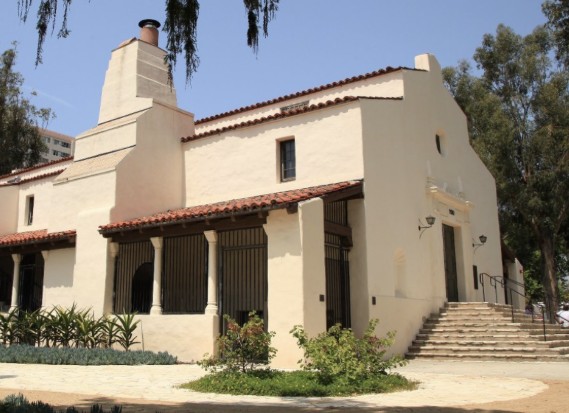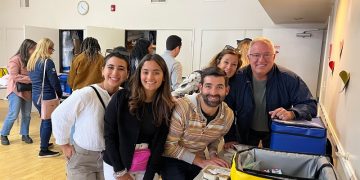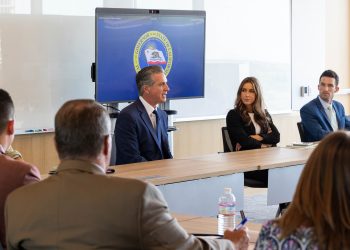
“The State of the City discussed by the mayor, is not surprisingly, still in a fiscal crisis but with good prospects for improvement” writes Mario Fonda-Bonardi
Last Thursday, July 17th, the City of Santa Monica held a different kind of State of the City address. Normally that annual event would be held in a large rented auditorium with a bunch of talking heads backed by a flashy power point presentation. But this time the State of the City address was re-envisioned by the Mayor Lana Negrete, as a city wide garden party at Reed Park (at Lincoln Blvd and Wilshire Blvd). This brought a very different feel to this traditional City event. This successful event was free, and open to everyone which symbolized a more accessible and transparent City. There were booths of all kinds, musicians, speeches, swag, food, games and other festive activities. The State of the City discussed by the mayor, is not surprisingly, still in a fiscal crisis but with good prospects for improvement. Essentially the City has not yet recovered from the austerity imposed the Covid pandemic and its collapse of retail sales, by the lack of tourism, by the continuing homelessness crisis, and by its large pedophilia legal penalties. These fiscal constraints make it hard for the City to fully return to “normal” operations (e.g. the libraries are still closed) and to respond to opportunities on our immediate horizon (e.g. the 2026 World Cup or the fast approaching 2028 LA Olympics).
We are, however, still a city in a desirable location: at the beach with its benign climate and upwind of Los Angeles. We have essentially a stable population in a diversified economy: hospitals, car sales, education, high artistic employment, abundant tourist facilities, and software industries. This desirable location and diversified economy translates to high property values and to the ability to survive previous fiscal crises: the depression of the thirties, the loss of our biggest employer, Donald Douglas, in the early sixties, the earthquake of 1994, and the recession of 2008 among others. Because our economic fundamentals are still good, we will slowly climb out of the hole we are in. How slowly we recover depends on the skill of our newly installed City manager, Oliver Chi (welcome aboard Oliver) and to the skill of the City Council knowing full well that many things are out of their direct control: eg the Trump turbulence (assault on immigrants and twisting tariffs), the interest rates and the relentless global warming/sea level rise.
So last week’s outdoor garden party at Reed Park was a refreshing reset for our City. It kicked off our year long 150th anniversary celebration. Our City was laid out a century and a half ago and the first lots were sold in that summer of 1875. Those first sales were the birth of Santa Monica’s powerhouse real estate industry we see today. As discussed above, while the City does not have the funds for elaborate 150th year festivities, it can celebrate with such simple fun events which capture the intimate charm of our small City. Holding the annual State of the City event in Reed Park, also symbolizes the public’s recapture of this City owned resource. For about a decade it has been overrun by homeless residents with the attendant ills of mental illness, of substance abuse and of anti-social behaviors. As such, many residents and visitors, particularly those with children, avoided this centrally located park because it felt unsafe. This created a vicious circle: the less frequented this Park became, the more the homeless moved in which made it feel even less safe for visitors and residents further reducing its public utility. So with modest improvements (fencing off the Miles playhouse) and improved enforcement, this important park can resume its critical central open space role in a densifying downtown.
The other significant park improvement is the reopening of the Miles Playhouse. This City landmark has been closed for refurbishment and is now reopened ready to resume its role as an intimate cultural Mecca for performances, parties, music, reunions exactly as it was conceived of by its founder almost a century ago. It was built in 1929 with $25,000 donated primarily by John Euclid Miles, a leading businessman and City Council member. Designed by a self taught Santa Monica architect, John Winford Byers, it is a prime example of Spanish Colonial Revival architecture. Byers, a former high school Spanish teacher, advocated for that style throughout Santa Monica and established a business designing and fabricating the bricks, roof tiles, and other construction elements needed for this traditional design style. This adobe styled building was battered but has survived three significant earthquakes: 1933, 1971 and 1994. It was designed, from the beginning, as a multipurpose building. The name “playhouse” refers to its role both as a recreation center literally for play and its theatrical role e.g. for staging plays. Its nominal 200 person flexible space has been used for countless meetings, plays, classes, exhibitions, practice sessions, performances and dramas. As such it was and is again an important cultural destination for the entire City of Santa Monica. Finally the reopened Playhouse will increase the pedestrian traffic in Reed Park altering the visitor to homeless ratio thus increasing its feeling of safety. This will help break the current vicious circle of the homeless driving out the visitors.
In a sense the Miles Playhouse is the twin cousin of another closed City landmark, the multi purpose Civic Auditorium (sometimes simply called the “Civic”) at Pico and Main Street. Like the Miles playhouse this nominal 3000 seat multipurpose space needs massive refurbishment for seismic, ADA accessibility, and for modern acoustic and thermal performance. It has been closed for the last 12 years because of seismic safety issues. Designed by the noted architectural firm of Santa Monica resident Welton Becket, the chief project architect was Loius Nadorf who is still alive today and expressed an interest in the successful reawakening of the Civic. For two thirds of a century, this now abandoned building has symbolized the City’s prominent national and even international cultural role. For 8 years in the 1960s it was the sexiest public auditorium where the Academy Awards were held. It also has a distinguished pedigree of innumerable rock stars, bands, musicians, singers and other luminaries who played there. Not to mention our countless public school children who also played there every year in an extravaganza called Stairway to the Stars (one of those public school performances was even conducted by Leonard Bernstein). Of course the scale of the required rehab is much bigger than the Miles Playhouse and our broke City cannot afford the multi million dollar rehab price tag. So the City has entered into an ongoing negotiating agreement with a private consortium to lease, rehab, and return the Civic to its original role as a premier multi purpose music venue.
Needless to say, bringing back the Civic would be an incredible boost to the City finances with its attendant major cash increase for the restaurant and hotel business sector.
The welcome resurrection of the Reed Park and the Miles Playhouse is a small step in the right direction. It augers well for the thousands of steps needed to bring back the Civic and eventually to put our entire City on solid financial footing. It’s a long road back but the longest journey begins with a single step.
By Mario Fonda-Bonardi AIA
S.M.a.r.t Santa Monica Architects for a Responsible Tomorrow
Mario Fonda-Bonardi AIA former Planning Commissioner, Robert H. Taylor AIA, Architect, Dan Jansenson, Architect & former Building and Fire-Life Safety Commission, Samuel Tolkin Architect & former Planning Commissioner, Michael Jolly, AIR-CRE Jack Hillbrand AIA Landmarks Commissioner Architect. Phil Brock SM Mayor (Ret), Matt Hoefler NCARB
For previous articles see www.santamonicaarch.wordpress.com/writing











